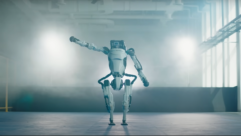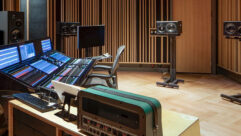On this edition of the SVC Podcast, Contributing Editor Bennett Liles completes his discussion with Project Manager Ben Davis from Sound Image on the sound and video upgrades completed at Arizona State University’s Neeb Hall. Ben outlines the installation of the new AMX control panels for sound and video operation, the Biamp Systems Tesira DSP and the way that Sound Image maintained simplicity of operation while providing versatility in control options.
Links of Interest:
· Sound Image with offices in California, Tennessee and Arizona
· AMX NX-3200 NetLinx NX Integrated Controller
· Shure ULXD4Q Quad Digital Wireless Receiver
· L-Acoustics Syva colinear speaker system
This is the SVC Podcast from Sound & Video Contractor with Ben Davis of Sound Image. Show notes and product links for this one and the other SVC podcasts are at svconline.com. Click the Podcasts link at the top of the page.
Arizona State University had a very short time to get their Neeb Hall completely upgraded with new sound and video so they called in a trusted partner with Sound Image. Separate sound systems for speech and media presentations are AMX controlled and there’s new video transport from SVSI. Project Manager Ben Davis, is back to wrap up the story here on the SVC Podcast.
Ben, great to have you back with us from Sound Image the Tempe, Arizona office to give us some more details on the Arizona State University Neeb Hall project. Sound system renovation with installation of two separate systems, both from L-Acoustics. When it came time to actually start getting your hands dirty on this one in Neeb Hall what was the first step? Was it removing the old system and was any of that repurposed? What did you do first?

At the beginning of the project the client thought we were going to have to repurpose some of the equipment, mainly from a cost standpoint. They did have a limited budget and they needed to do some video upgrades as well. Luckily, the L-Acoustics product, the WiFo and the Syva product, were both very cost effective solutions so we were actually able to do a full upgrade on audio, video and control in the space. So that gave us the opportunity to really have a fresh start. Obviously you replaced both speaker systems. The previous speaker system was just a left/right. It didn’t have the center cluster, so we added a center cluster. We replaced the left and the right with Syva’s. And they also had ceiling speakers as delays and we were able to, with the L-Acoustics Solution, not need the ceiling speakers. It’s much more coherent coming from one source for speech. The left and right media with the Syva and the Syva Low has a really good low frequency experience so for their performance based type events that they do in there – there’s a couple of churches that rent out the space on the weekend – they’re able to utilize that for a band and for music as well as media presentations they do. But we were able to look at it holistically and one of the directives that the university has given us on many of their projects, they’re trying to make everything be networked; everything on the network. Their future vision is to be able to have the flexibility of being able to do overflow, if you will, or tie multiple facilities together. So the entire system is on their network audio, video, control, it’s all on the network. And the universities use Biamp a lot in these installs, so we looked at the TesiraFORTE Dante as a solution. So we have all the audio Dante side on their network and the control system is AMX on their network. And then we utilize SVSI for video, so that is also on their network. So all three products as well as, actually lighting is the third one, are all on the network. They have supervision of the entire system remotely as well as the ability that in the future if they just decide to want audio and video to go to a neighboring facility they can easily route it to another facility for overflow or for a collaborative type meeting. [Timestamp: 3:42]
And what did you do on the video side of it?
The video side we used a Panasonic projector. They had an existing screen, motorized screen that’s upstage. So we upgraded the video transport system with SVSI, but the projector had been updated about a year ago so it was a Panasonic 1080p projector already so we didn’t have to upgrade that, which is a good cost savings. But that’s what we did for video. [Timestamp: 4:09]
And how did you install the AMX panels? I think you used AMX touch panels for the sound control.
Yeah. Every teaching station gets a touch screen. We did a 10-inch touch screen from the, from AMX. And what’s great about those touch screens is they’re very clean and they’re capacitive such so they’re multipoint touch. We were able to integrate motion buttons and very easily make a intuitive touch panel. From an audio standpoint, one of the things we like to do is try to give as much control as we can without taking away from it being easy to use. So for us, we break everything into speech volume and program volume. And we also like to spend time tuning the audio system so that when the instructor takes the speech volume and turns it all the way up they know that they’re safe – there’s not going to be feedback if they do that – but not limit them so there’s not any headroom. So it’s a balancing act between the design of the speaker, the placement of the speaker, the choice of the microphone and the EQ-ing that happens in the commissioning stage so that they get lots of headroom. They don’t feel limited, but they also feel safe that any time they go into one of our installs they can turn that volume all the way up. I always tell my guy at the commissions, “Always give them to 11. Let them turn it up to 11 and know that it’s not going to feed back.” [Laughs] So that’s always our objective and our goal when we do control systems. [Timestamp: 5:44]
Ah well, if it goes to eleven, the old Spinal Tap movie axiom still applies to modern sound systems. Did you have to make any electrical changes to the building to accommodate the new sound gear you put in?

No, and that was one of the caveats with this is to keep costs down they wanted to not have to do electrical work. So with it being a networked project, in the original install of the system they had two large racks – one onstage, one in a projection booth at the entry of the venue – that were full of equipment. That’s why I had plenty of power between the two, but not necessarily enough power all at one. So because it was networked I was able to split up the amplifiers and the DSP based on A) where I had power and B) where the existing cabling for the speakers were and keep it all on their network and keep it all behaving as one, but keep the costs down by just moving the assets where we had infrastructure to support it. So we didn’t have to add any power and we went from two full racks of equipment and a teaching station full of equipment down to a couple RU of equipment in the teaching station and a couple RU onstage and a couple RU in the projection booth. So we have largely empty racks now. [Timestamp: 7:07]
OK and I know they do a lot more than just lectures in there. I think there are actually some live music performances in Neeb Hall, too. Seems like I saw some pictures of those on their site. So how do they use the system for those?
We give them, at the teaching station and in the audio booth in the back, we gave them the ability to either via the network add a live mixing console or we have analog inputs and outputs. So I mean the venue is utilized for music – and like I referenced before there’s some church groups that rent out the space. So they can either tie their system, their console, into those or what also gets utilized a lot is they do events that either get web streamed or get archived for later or get broadcast out and they want to be able to get audio out of the system. So we added three XLR’s on there. One is speech only, one is program only, and then one is combined of the two. And the few different production companies that have come in have found it really easy. They always ask me, “All right, where can I tie into the system? Can you program something to give me some audio? Where’s the soundboard?” So it’s actually easy plugging into that. They’re always skeptical. They plug in expecting to have either a really thin-sounding audio because of all the EQ we would have had to do to try to make it work in the space, or really muddy-sounding audio. They plug in; they find it really even and natural-sounding coming straight out of the output. And that really is because A) of how we set up the DSP infrastructure, but B) because of the sum of all the parts gave us what we needed. We didn’t have low frequency issues that we had to deal with in EQ. We really look at every single piece and how they’re going to add up together so that we have an easy-to-manage system. We don’t have to do a lot of EQ-ing. We don’t have to butcher any microphones. So all the different types of events they use it for, we try to give them all the little connections and hookups they need to make that happen. [Timestamp: 9:06]
So designed and installed by experts to be operated by let’s say very non-experts.
[Laughs] Yes. That is one of the most challenging parts of it is kind of like what I was saying before. How do you give someone flexibility, control and not take away from it being easy? To have an easy button for every type of use is really difficult. You don’t want to give them too much control so that the user stares at a touch screen and is not sure how to just turn on the projector, how to make sound and do their event, but you don’t want to pigeonhole them into, “Oh, well you can only do presentations in here. You can only do concerts in here. Oh, you can only do…” We want to make it so that you have all the angles covered to a certain extent, obviously, but 90-95 percent of anything they would ever do in that space is covered with the easy on button and everything is intuitive and simple. [Timestamp: 10:05]
So anybody can work it. Now, what was your time frame in getting the whole thing finished? Did you have to work around other things going on during the installation?
Yeah. We did get to do the install during summer break. They did have some events, summer classes and whatnot, that go on in that space. The main one was we had to get it done within a week and have it ready for the weekend when the churches that rent the space needed it. So we always had to make sure that by the end of the week it was functional for them to use it. [Timestamp: 10:35]

Quite a bit to get done in a pretty short time but you made it so what have the folks at Sound Image got up their sleeves next in the way of more projects?
Yeah. Right now we’re working on Phase 3 of Sun Devil Stadium, which is their 67,000 seat football stadium. We’re in the third phase – another phase comes up next year. We’re building what they call the 365 venue. It’s a multipurpose stadium. They’re really looking at how to leverage a stadium to not be just football; how they can get use out of it 24/7. So that’s one project we have and we’re working on a couple of other performance halls. Our Escondido office is working on a few casinos. A lot of different projects going on. Audio video doing some control work for the stadium as well; upgrading everything to HD as well as new video boards. We have a lot of different things going on. [Timestamp: 11:30]
Great hearing about this one and when you get some of these other projects done maybe we’ll want to talk about those.
Yeah.
We’ve been talking to Ben Davis with Sound Image and Arizona State University’s Neeb Hall. Brand new video and sound for any event they have. Ben, good luck on these other projects and thanks for getting with us on this one.
Great. I appreciate it, Bennett.
A remarkable job on speech clarity, media sound and multi-system control made so simple that it’s all push button easy. Looking forward to hearing from Sound Image on future projects. Get back with us next week for another firsthand AV installation story on the next SVC Podcast.










